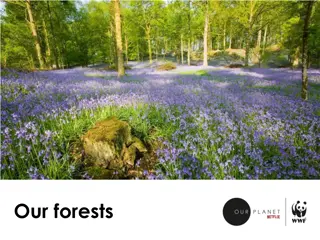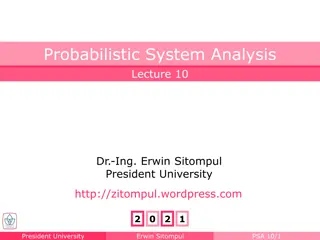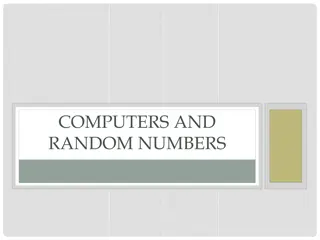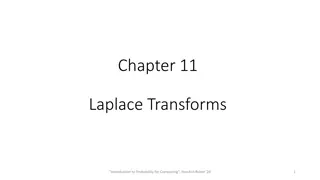Understanding Random Forests: A Comprehensive Overview
Random Forests, a popular ensemble learning technique, utilize the wisdom of the crowd and diversification to improve prediction accuracy. This method involves building multiple decision trees in randomly selected subspaces of the feature space. By combining the predictions of these trees through a majority voting mechanism, Random Forests can handle both classification and regression tasks effectively. This article delves into the history, construction, and advantages of Random Forests, highlighting their applications through a detailed case study.
Download Presentation

Please find below an Image/Link to download the presentation.
The content on the website is provided AS IS for your information and personal use only. It may not be sold, licensed, or shared on other websites without obtaining consent from the author. Download presentation by click this link. If you encounter any issues during the download, it is possible that the publisher has removed the file from their server.
E N D
Presentation Transcript
Random Forests Md. Abu Sayed
Outline Introduction History of Random Forests What is a Random Forest? Why a Random Forest? Case Study
Introduction Random Forests can be regarded as ensemble learning with decision trees Instead of building a single decision tree and use it to make predictions, build many slightly different trees Combine their predictions using majority voting The main two concepts behind random forests are: The wisdom of the crowd a large group of experts are collectively smarter than individual experts Diversification a set of uncorrelated tress A supervised machine learning algorithm Classification (predicts a discrete-valued output, i.e. a class) Regression (predicts a continuous-valued output) tasks.
History of Random Forests Introduction of the Random Subspace Method Random Decision Forests [Ho, 1995] and The Random Subspace Method for Constructing Decision Forests [Ho, 1998] Motivation: Trees derived with traditional methods often cannot be grown to arbitrary complexity for possible loss of generalization accuracy on unseen data. The essence of the methods are to build multiple trees in randomly selected subspaces of the feature space. Trees in, different subspaces generalize their classification in complementary ways, and their combined classification can be monotonically improved. [Ho, 1995] Tin Kam Ho, "Random decision forests," Proceedings of 3rd International Conference on Document Analysis and Recognition, Montreal, QC, Canada, 1995, pp. 278-282 vol.1, doi: 10.1109/ICDAR.1995.598994. [Ho, 1998] Tin Kam Ho, "The random subspace method for constructing decision forests," in IEEE Transactions on Pattern Analysis and Machine Intelligence, vol. 20, no. 8, pp. 832-844, Aug. 1998, doi: 10.1109/34.709601.
What is a Random Forest? Combined the Random Subspace Method with Bagging. Introduce the term Random Forest (a trademark of Leo Breiman and Adele Cutler, 2001) Random Forests [1] The generalization error of a forest of tree classifiers depends on the strength of the individual trees in the forest and the correlation between them. [Breiman, 2001] Breiman, Leo. "Random forests." Machine learning 45 (2001): 5-32.
What is a Random Forest? We have a single data set, so how do we obtain slightly different trees? 1. Bagging (Bootstrap Aggregating): Take random subsets of data points from the training set to create N smaller data sets Fit a decision tree on each subset Results in low variance. 2. Random Subspace Method (also known as Feature Bagging): Fit N different decision trees by constraining each one to operate on a random subset of features
Bagging at training time N subsets (with replacement) Training set
Bagging at inference time A test sample 75% confidence
Random Subspace Method at training time Training data
Random Subspace Method at inference time A test sample 66% confidence
Random Forests Tree2 Tree1 Random Forest TreeN
Random Forests Algorithm For b = 1 to B: To make a prediction at a new point x we do: For regression: average the results For classification: majority vote (a) Draw a bootstrap sample Z of size N from the training data. (b) Grow a random-forest tree to the bootstrapped data, by recursively repeating the following steps for each terminal node of the tree, until the minimum node size nminis reached. i. Select m variables at random from the p variables. ii. Pick the best variable/split-point among the m. iii. Split the node into two daughter nodes. Output the ensemble of trees.
Case Study An innovate approach for retinal blood vessel segmentation using mixture of supervised and unsupervised methods IET Image Processing, Volume: 15, Issue: 1, Pages: 180-190, First published: 30 November 2020, DOI: (10.1049/ipr2.12018)
Case Study An innovate approach for retinal blood vessel segmentation using mixture of supervised and unsupervised methods IET Image Processing, Volume: 15, Issue: 1, Pages: 180-190, First published: 30 November 2020, DOI: (10.1049/ipr2.12018)
Case Study An innovate approach for retinal blood vessel segmentation using mixture of supervised and unsupervised methods IET Image Processing, Volume: 15, Issue: 1, Pages: 180-190, First published: 30 November 2020, DOI: (10.1049/ipr2.12018)
Why a Random Forest? Accurate predictions Standard decision trees often have high variance and low bias High chance of overfitting (with deep trees , many nodes) With a Random Forest, the bias remains low and the variance is reduced thus we decrease the chances of overfitting Flexible Can be used with many features Can be used for classification but also for regression Disadvantages: When the number of variables is large, but the fraction of relevant variables is small, random forests are likely to perform poorly when m is small
References [1] Breiman, Leo. "Random forests." Machine learning 45 (2001): 5-32. [2] Faculty of Mathematics and Computer Science, University of Bucharest. (n.d.). Practical Machine Learning [Decision Trees, Random Forests]. Practical Machine Learning. Retrieved May 1, 2023, from https://practical-ml-fmi.github.io/ML/ [3] Pramoditha, R. (2020, October 29). Random forests - an ensemble of decision trees. Medium. https://towardsdatascience.com/random-forests-an-ensemble-of-decision-trees-37a003084c6c
Characterizing the accuracy of RF Margin function: which measures the extent to which the average number of votes at X,Y for the right class exceeds the average vote for any other class. The larger the margin, the more confidence in the classification. Generalization error:
Characterizing the accuracy of RF Margin function for a random forest: strength of the set of classifiers is suppose is the mean value of correlation the smaller, the better























